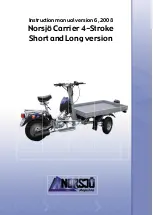
21
Braking/Stopping
Always allow plenty of room and time to
stop smoothly. Sometimes quick stops
are inevitable, so always be prepared.
Whether you’re stopping slowly or stop-
ping quickly, do this:
1. Release the accelerator; then press the
foot brake pedal to apply the brake.
2. If the wheels lock, release them for a
second; then apply them again. On
surfaces such as ice, mud, or loose
gravel, pump the brake pedal rapidly.
3. Never “ride” the brake. Even maintain-
ing minimal pressure on the brake pedal
will cause the brake pads to drag on the
disc and may overheat the brake fluid.
Parking
Parking involves following the previous
rules for braking; then:
1. After the vehicle stops, shift into
park; then turn off the ignition.
2. If you have to park on a hill, block the
wheels on the downhill side.
Basic Turns
Steering effort is at its lowest in two-wheel
drive (2WD). Greater effort is needed
when in four-wheel drive (4WD). The
greatest effort is needed when in four-
wheel drive and the differential is locked.
Never exceed 10 mph (16 kph) with the
lock control in the LOCK position.
Slow down before entering a turn. The
basic turning technique is to drive at low
speed and gradually adjust the amount of
steering to suit the driving surface. Do
not make sudden sharp turns on any sur-
face. Refer to the sub-sections Driving
Uphill, Driving Downhill, Crossing
Obstacles, Driving in Reverse, Skidding
or Sliding, Crossing Water, or Crossing
Roads for more information.
If your vehicle ever skids sideways during
a turn, steer in the direction of the skid.
Also, avoid hard braking or accelerating
until you have regained directional control.
Driving Uphill
Always drive straight up the hill and
always avoid hills steeper than 15°.
1. Keep both hands on the wheel.
2. Prior to starting the climb, shift into
low range, select four-wheel drive for
traction, and gradually press the accel-
erator; then maintain a constant speed.
3. If the vehicle stalls on a hill, press the
foot brake pedal to apply the brake,
shift into reverse, and slowly back
down the hill. Do not attempt to turn
around on a hill.
! WARNING
Excessive repetitive use of the
hydraulic brake for high speed stops
will cause overheating of the brake
fluid and premature brake pad wear
which will result in an unexpected
loss of brakes.
! WARNING
Use only Arctic Cat approved brake
fluid. Never substitute or mix differ-
ent types or grades of brake fluid.
Brake loss can result. Check brake
fluid level and pad wear before each
use. Brake loss can result in serious
injury or death.
! WARNING
Use care in turns - turning the steering
wheel too far or too fast can result in
loss of control or a rollover. Excessive
speed, driving aggressively, or making
abrupt maneuvers, even on flat, open
areas, can cause loss of control, tipping,
or rollover. Uneven terrain, rough terrain,
soft surfaces, slippery surfaces, and
paved surfaces can also cause a loss of
control or rollover in a turn. On loose or
soft surfaces, allow yourself more time
and distance to turn and slow down.
! WARNING
Do not attempt to turn around on a hill.
! WARNING
Driving up hills improperly can cause
loss of control of the vehicle resulting
in serious injury or death. Use extreme
care when driving in hilly terrain.
Summary of Contents for 2015 WILDCAT SPORT
Page 1: ...O P E R A T O R S M A N U A L www arcticcat com WILDCAT TRAIL XT ...
Page 59: ...57 Maintenance Record DATE MILEAGE SERVICE PERFORMED NOTES ...
Page 60: ...58 Maintenance Record DATE MILEAGE SERVICE PERFORMED NOTES ...
Page 61: ...59 Maintenance Record DATE MILEAGE SERVICE PERFORMED NOTES ...
Page 62: ...60 NOTES ...
Page 63: ...61 NOTES ...
Page 64: ...62 NOTES ...
Page 68: ... 2014Arctic Cat Inc Trademarks ofArctic Cat Inc Thief River Falls MN 56701 p n 2260 359 ...
















































